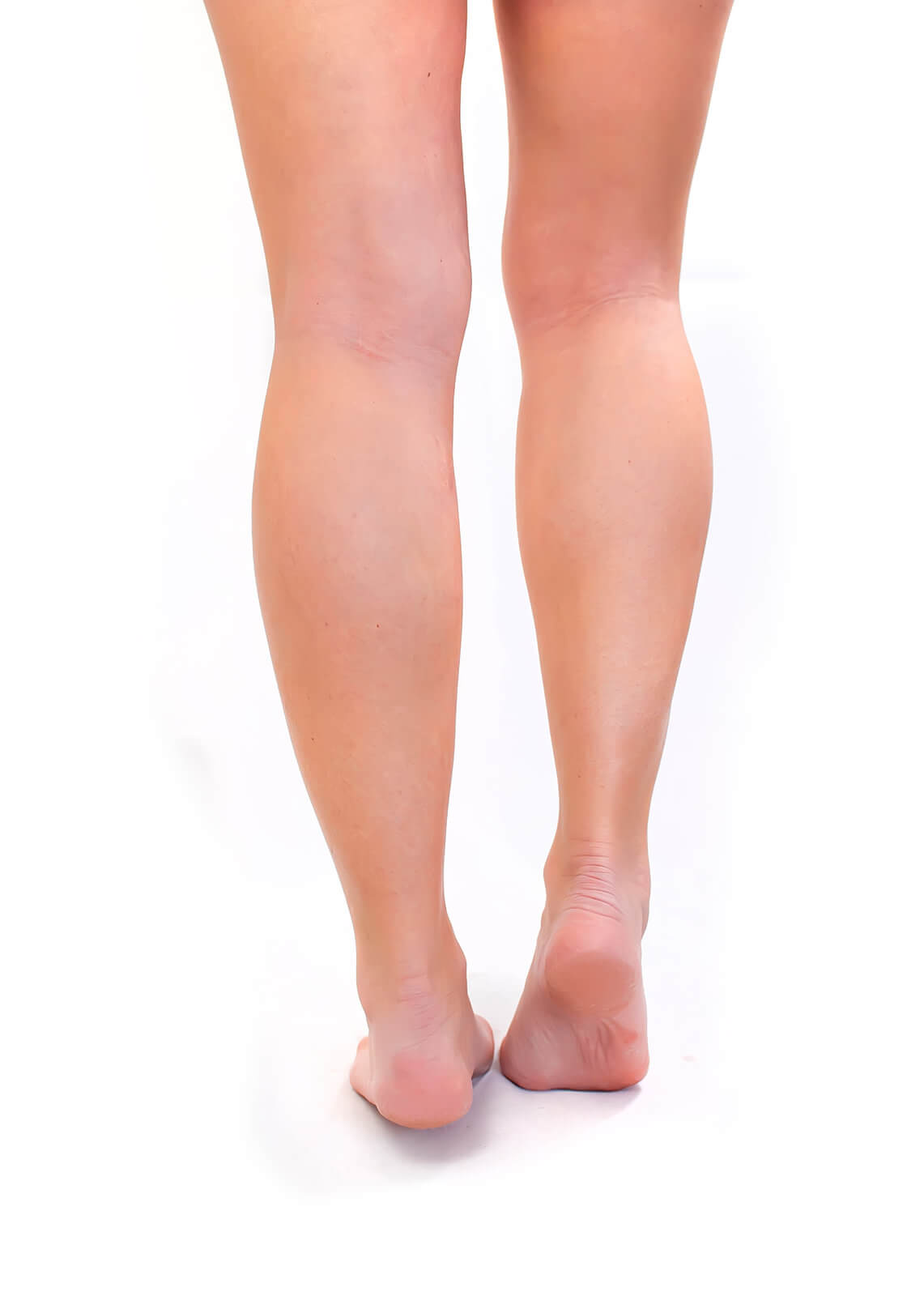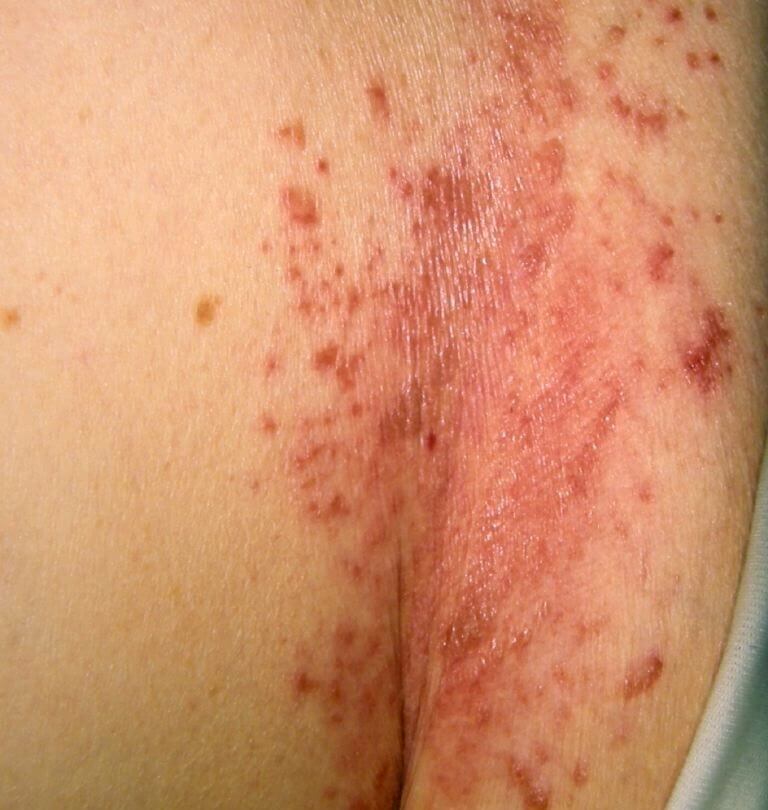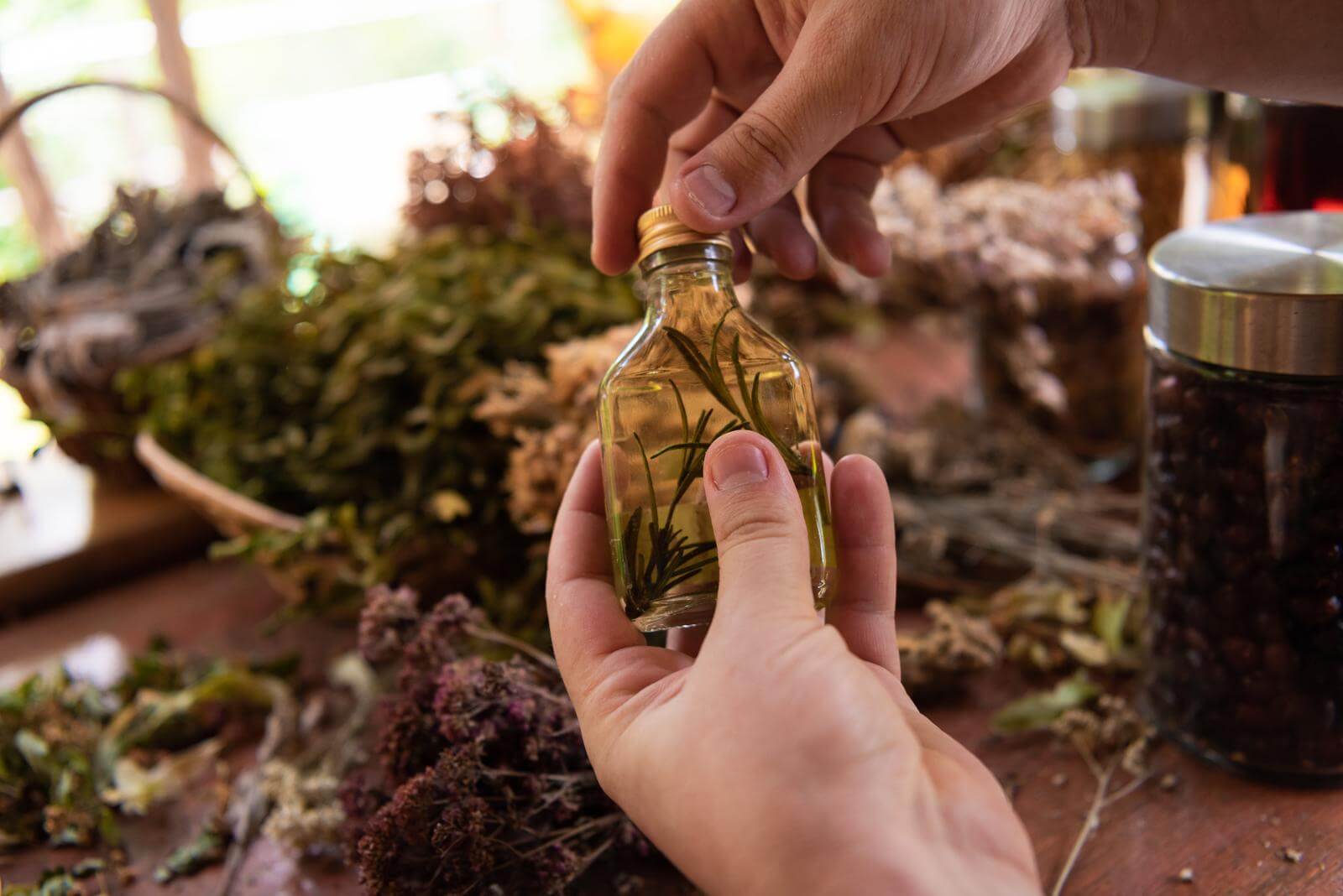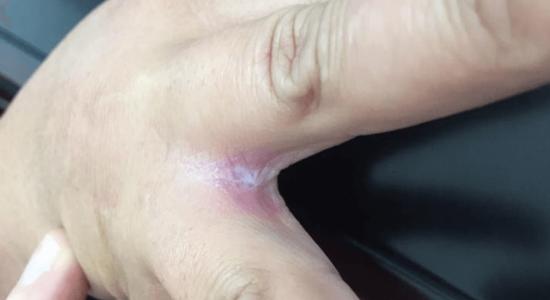
A behind the knee yeast infection is actually a form of Candidal intertrigo. Intertrigo (intertriginous dermatitis) is a rash that shows up in the skin folds, or where skin touches skin. Intertrigo can be induced or aggravated by moisture, heat, friction, and a restriction of air flow to that area. Often, intertrigo is made worse by infection of some kind; the most common infective agent for these rashes is Candida.
Candida is a genus of yeast that causes yeast infections. According to the United States MedlinePlus, "[Candida] is a fungus that lives almost everywhere, including in your body. Usually, your immune system keeps yeast under control. If you are sick or taking antibiotics, it can multiply and cause an infection."
The area behind the knee, known scientifically as popliteal fossa, is an area where skin touches skin. It can therefore be subject to an episode of intertrigo. Since Candida is the most common infection that occurs with intertrigo, it is likely that your behind the knee intertrigo is infected with Candida—if you suspect some kind of infection in that area.
In this article, Candidal intertrigo is discussed as it will be closely approximated to all types of behind the knee Candida infections. The research discussed in this article will present the symptoms of Candidal intertrigo; and, provide a picture of Candidal intertrigo which may help you more accurately diagnose a behind the knee infection.
Not all intertriginous infections are caused by Candida. Therefore, if the infective agent is a bacteria, you may have failed in treating the problem with a synthetic antifungal drug. It is therefore prudent to assess your susceptibility to Candida infections and learn the symptoms of these infections. By properly diagnosing your infection, you will be able to know how to treat yourself. If you do not have a yeast infection behind the knee, using an antifungal may not provide any amelioration to your situation.
Candida Hub provides two home yeast infection tests you can take to better assess your propensity to have Candida related health issues. These tests were adapted from the work of the famous Dr. William Crook. This may facilitate your efforts to arrive at a correct diagnosis. You can take these tests on this website for free by visiting the page linked below.
A 1/2 Day & Yeast is Gone!
Linda Allen suffered from yeast infections for years. Through researching natural medicine & Candida, she found an efficacious solution!
Linda is one expert you want on your side! Let her show you how to get rid of a superficial yeast infection in just 12 hours; AND, keep it gone!
A 60-day, 100% money back guarantee is provided.
Visit Official Site!Research Related to Behind the Knee Candidiasis

The first study we will examine investigated skin surface pH, and moisture in intertriginous areas, in diabetic patients and healthy control subjects. The study also examined these variables in their relation to Candida intertrigo. This research was published in Diabetes Care [16.4 (1993): 560-563].
According to the study, it is widely accepted that skin yeast infections are more common in diabetic individuals. Yet, at the time of this study’s writing, the way by which diabetes increases host susceptibility to Candidiasis was not clear. Yet, one of the factors that contributes to Candida growth is body area pH.
The pH of skin in healthy adults is acidic and is in the range of 4 and 6. The acidity of the skin is thought to be the result of lactic acid, sebum, amino acids in sweat, and protein substances in the stratum corneum (the outer layer of the skin—the epidermis). The study also states that skin pH is higher in females and also is determined by skin humidity. The study states that an important predisposing factor, for an intertriginous yeast infection, is increased skin humidity caused by having a skin area covered, sweating, and maceration (maceration happens when the skin is in contact with moisture for too long—the skin becomes wrinkled and lighter in color).
The research found that non-insulin-dependent diabetes mellitus (NIDDM) patients had a significantly higher pH in intertriginous areas. Of the NIDDM patients, 12% of them had Candidal intertrigo. The study indicated that in intertriginous regions, skin surface pH of NIDDM patients is significantly higher than in normal control subjects; this implies the significance of skin pH as a possible factor behind a person’s susceptibility to skin yeast infections.
The next study we will look at was published in Clinical, Cosmetic and Investigational Dermatology [11 (2018): 175]. The study’s focus was recurrent Candidal intertrigo.
According to this study, intertrigo is a inflammatory condition that occurs in opposing skin surfaces in response to friction, humidity, reduced air circulation, or maceration. Intertrigo is a common skin problem that can be localized to a small area or involve larger areas of the body.
The primary factor in the development of intertriginous lesions is the mechanical friction on the skin. This initially presents as slight reddening of the skin folds. Heat, humidity, reduced air flow, and maceration promote intertrigo. Although this condition can happen to anyone, it is more common in diabetic, obese individuals that live in hot and humid climates, and in bed-ridden or eldery individuals. Many yeasts—particularly Candida—bacteria, molds, and viral infectious pathogens can make intertrigo worse by colonizing the skin.
Concerning Candida, the study states that C. ablicans is part of the normal microscopic flora in the skin, genital mucosa, and/or intestinal mucosa (mucosa relates to mucus membranes) in 70% of healthy people. C. albicans is an opportunistic pathogen; which means it often requires an opportunity to overgrow and cause infection. C. albicans exists as a commensal yeast (a commensal organism is one that derives a benefit from another organism without causing it harm) in people with an intact immune system. C. albicans can cause systemic infections when conditions are right for this to occur.
The study goes on to state that C. albicans is responsible for approximately 80% to 90% of all skin infections caused by Candida species. Some of the symptoms of intertriginous Candidiasis are as follows:
- Reddening of the skin
- Skin maceration
- A foul smell
- Skin crusting
- Skin fissuring (small tears in the skin)
- Folliculitis (inflammation of the hair follicles)
- Pustules (pus filled bumps)
- Papules (small, raised bumps on the skin)
- Skin itching
- Satellite lesions
- Plaques
- Stinging
Another study also discusses intertrigo and Candida. The research was published in the British Journal of Healthcare Assistants [12.10 (2018): 479-485].
The study relates that most intertrigo infections are caused by Candida. The symptoms of this condition are stated as skin covered by a white / yellow foul smelling discharge. And, although most infections are caused by candida, individuals with intertrigo can develop bacterial infections. A certain bacterial infection, caused by Pseudomonas aeruginosa, can be identified by a characteristic smell and because the infection stains underwear or sheets a blue / green shade.
The study also provides a picture of a woman who had a characteristic appearance and smell of Candidal intertrigo infection. The woman’s skin was very red and sore. The woman was quite obese, and the infection was in her abdomen and vulva. The decision was made to wash the woman’s skin twice daily. Because her skin was sore and red, she was told that they would wash her skin with emulsifying ointment and pat it dry to reduce irritation and to facilitate healing. Clotrimazole HC (an antifungal drug) was applied to her clean, dry skin.
Eliminate Bacterial Vaginosis & Vaginal Odor
Jennifer O’Brien is one prominent expert on BV that knows how to get rid of vaginal odor. BV is a common infection that you don’t have to put up with.
Jennifer will show you how to naturally eliminate vaginal odor in just 3 days.
A 60-day, 100% money back guarantee is provided.
Visit Official Site!Naturally Curing Behind the Knee Yeast Infections (Candidal Intertrigo)

Valerie Ann Worwood, in her book The Complete Book of Essential Oils and Aromatherapy, discusses intertrigo. Worwood states that inflammation and soreness can affect skin that is in contact with another skin surface—most notably in areas with more moisture like around the groin. If the skin is not adequately dry, intertrigo can be caused by fungal, bacterial, or viral pathogens. When intertrigo is present, the skin can take on an unpleasant appearance and have a foul smell.
Worwood suggest the following natural protocol to treat intertrigo:
Blend the following ingredient mixture and use it to wash the area twice a day for one week:
Intertrigo Mixture
- Lavender Essential Oil: 5 drops
- Eucalyptus Lemon Essential Oil: 10 Drops
- Directions: Add the essential oils to 2 1/2 cups (600 mL) of water. Use approximately 3 1/2 fluid ounces (100 mL) with each washing.
After washing and drying, use the following body powder with the base medium being a finely powdered white clay. Make sure to mix the ingredients completely—you may want to use a blender. Be careful not to inhale the mixture. Dust some of the following mixture over the intertrigo after you wash and dry it.
Intertrigo Powder
- White Clay / kaolin (powdered): 4 ounces
- German Chamomile Essential Oil: 10 drops
- Rosemary Essential Oil: 10 drops
- Lavender Essential Oil: 10 drops
Using Apple Cider Vinegar

Apple cider vinegar is a great natural remedy for yeast infections. Just a 0.5% concentration of acetic acid (the acid in apple cider vinegar; and, all vinegars for that matter) has been shown to kill Candida.
As you may know, typically vinegar will be sold with a 5% concentration of acetic acid. Yet, using undiluted vinegar on the skin for prolonged periods of time, or with some frequency, can cause burns to occur. When you are trying to treat a behind the knee yeast infection, you will not want to further aggravate the skin by inducing a mild chemical burn.
Because a 1.0% concentration of vinegar will kill Candida, you should dilute your apple cider vinegar to a 1 to 10 ratio in water. This will reduce the acetic acid in the solution down to 0.5%. The overall concentration of vinegar will be just 10%; which should be more than enough to kill Candida. This should be much safer for the skin, while at the same time, killing the yeast infection behind the knee.
If you notice your skin becomes irritated from this diluted vinegar, you can discontinue using it, or further reduce the concentration of acetic acid, by adding more water to the apple cider vinegar. Very small concentrations, about 0.05% apple cider vinegar, may be able to inhibit Candida to some extent. So you really do not need too strong of a concentration to see some salubrious results.
There is a lot more information on Candida Hub about apple cider vinegar and using it as a yeast infection treatment. This information is, of course, beyond the scope of this article. Yet, if you would like to learn more about this capable natural remedy, you can peruse the section on Candida Hub about this vinegar. The apple cider vinegar and primary article are linked directly below:
Concerning washing the intertriginous area behind the knee, you can use a similar format to the one proposed by Valerie Ann Worwood in her book The Complete Book of Essential Oils and Aromatherapy. Simply use diluted apple cider vinegar instead of water for the washing mixture.
Additionally, for killing off a yeast infection, it may be wise to substitute different essential oils for the ones that Worwood recommended for intertrigo. Different essential oils will have different therapeutic efficacies against Candida; and some essential oils may not have any ability to inhibit or kill this fungal pathogen.
Three potent essential oils against Candida are tea tree, thyme, and oregano essential oils. All three of these oils are powerful natural treatments for yeast infections. And, by using them in conjunction, you may get a healing synergy to occur—making them better than any one single oil by itself. Additionally, there is a lot more information about each of these oils on Candida Hub. Becoming informed about these oils should be paramount before you use them; just make sure you get good information backed by scientific research. If you would like to learn more about these oils, you can check out the following articles that go over, in detail, these oils and Candida.
The prominent herbal medicine expert, and late, Dr. James Duke discussed the healing synergy of antifungal essential oils in his book The Green Pharmacy. According to Dr. Duke, using more than one antifungal oil to treat a fungal infection often produces a synergistic effect. The following quote delineating this fact was taken from Dr. Duke’s The Green Pharmacy book:
The synergy—the harmonious working together—of antifungal herbs has been demonstrated in several studies. In one test of ten plant species whose oils were antifungal, researchers noted that "combinations of the antifungal essential oils increased their activity remarkably." In a similar study, researchers noted that "in all the oil combinations, the antifungal potency was found to increase over individual oils."
Duke, James A.. The Green Pharmacy
Something to consider if you are considering using these oils, is they may be very strong on the skin and could instigate contact dermatitis (a skin rash caused by exposure to a substance).
To see how your skin will react to each essential oil, you may want to do a patch test of each oil before you use them behind the knee. To perform a patch test, simply place a very small amount of an essential oil on an insensitive area of the skin (such as the upper arm). After you apply the small amount of the oil, allow it to sit on the skin for about an hour. If you notice any inflammation or rash, you will know that your skin does not tolerate the essential oil. In such cases you will not want to use that essential oil.
After you certify that these oils will not adversely react with your skin, you can modify the recipes provided by Valerie Ann Worwood, to be better suited to combat Candidal intertrigo. If you notice any irritation when using the essential oil mixtures, simply reduce the concentration of essential oils, or discontinue use. Doing this should provide you with a viable, natural cure that will possibly work as well or better than prescription antifungal medications! Within a few days you may be able to clear up a behind the knee Candida problem.
Clair Goodall: Author & Nature Lover
Clair Goodall is a bee-obsessed natural medicine convert from Minnesota. She is one expert you might want to know more about!
Clair will help you protect you and your family from toxic products and chemicals and help you discover solutions from nature.
Also, Clair’s book is backed by a 60-day, 100% money back guarantee
Visit Official Site!Naturally Curing a Yeast Infection in Only 12 Hours

Yeast infections can affect men and women; yet, it is probably a condition that affects women far more than men. Although Candida overgrowth can occur anywhere in the body, and in the digestive system, the vaginal area is a common zone Candida attacks.
According to a study published in Obstetrics & Gynecology [120.6 (2012): 1407-1414], approximately 75% of all women will develop a yeast infection during the course of their life. Recurrent vaginal yeast infections are an even more arduous experience; and can ruin a woman’s quality of life. This study reported that approximately 5% to 8% of women in their reproductive years suffer from recurrent yeast infections. The study also relates that recurrent yeast infections can impair sexual function, be costly to treat, and can cause intense suffering.
One woman, Linda Allen, spent about 12 years suffering from recurrent yeast infections, and systemic Candidiasis (a condition where Candida invades the body, often in the intestines). Her story may sound familiar to those of people you know, or be similar to your own situation.
When Linda first got a yeast infection, she decided to see a medical doctor about the problem. She was prescribed medication, and took it. The medication worked and eventually her yeast infection cleared up. Yet, eventually Linda found that she developed another yeast infection. No matter what Linda tried she was not able to stop her recurrent yeast infections.
While Linda was struggling with outward yeast infections, she found her health was in disarray. She felt terrible and had strange symptoms she didn’t know how to address. Her doctor was unable to offer much help either. Linda was even put on allergy medication to try and resolve her symptoms; but, nothing seemed to work.
Those who knew Linda began to wonder if she was a hypochondriac or in worse health than she was admitting. Linda ended up spending a small fortune on medical bills. At a time when she should have been able to afford a better living arrangement, she found herself living in a tiny apartment. And, her health kept deteriorating despite her efforts. Linda felt like she had tried everything without finding a solution.
Linda’s life took an important turn for the better when she visited a naturopath. The naturopath, at last, provided Linda with a correct diagnosis for her unusual health problems: systemic Candidiasis. Linda had the yeast Candida overgrowing in her body and this was the reason for her recurrent yeast infections and poor health.
The naturopath did not provide Linda with a permanent solution to her health problems, but they did put her on the right path. After Linda was diagnosed, she spent a considerable amount of effort investigating Candida and methods for treating it. Linda inquired of health professionals who were kind enough to lend her some time. Allen even tried a wide array of purported cures for Candida; learning through experience.
Eventually Linda developed a natural treatment protocol she hoped would get rid of her Candida overgrowth. After developing her protocol, Linda spent about a year refining it before she tried it on herself.
When Linda implemented her natural treatment plan, she found that her yeast infections stopped happening. After she started the treatment plan, she also began to notice her health improve. Eventually, Linda felt great again. Her sinus problems, stomach problems, and lethargy disappeared.
To be certain she was recovered, Linda returned to a few physicians and asked them to run tests on her. Linda’s tests results showed that all indicators of infection had disappeared. She was certainly healthy again after so many years of struggling.
Linda also had a doctor suggest she show her treatment plan to others; and, Linda did just that. After Linda gave her natural protocol to others suffering from Candida, she would hear back positive reports. They too used her system and replicated her success.
Eventually, Linda decided to write a book detailing her natural treatment plan to get rid of Candida. Linda also outlines a 12 hour, natural treatment plan that can cure an outward yeast infection in just 12 hours of time. Additionally, Linda also addresses how to cure systemic Candida problems as well. If you have been suffering from recurrent yeast infections, Linda’s treatment plan could dramatically change your life for the better.
Linda Allen has published her book in a digital format that can be downloaded instantly. You do not have to wait for a hard copy of her book to get started—you can download it safely online. Additionally, Linda Allen has published her book with a prominent digital retailer—a subsidiary of the United States based firm Keynetics Incorporated.
Linda’s publisher has excellent customer service and a secure buying process. In addition to doing all the “hard lifting” for Linda, her publisher provides a 100%, 60 day money back guarantee on Linda Allen’s book. If you are not satisfied with Linda’s book, you have a full 60 days, after purchasing it, where you can get a full refund of your money. This really helps allay any apprehension by making sure you will not have to pay if you found her book unsatisfactory.
If you would like to learn more about Linda’s personal story, see reports from others who tried Linda’s treatment, or find out more about her book; you can get more information at Linda Allen’s website.
Author: Mr. Nicholas Gross

Nick Gross is a natural medicine enthusiast who has been researching and writing about natural medicine since 2008. Nick is primarily a web developer but also researches and authors written and video content about natural health. Nick has a bachelor’s degree in Management Information Systems from the University of Northern Iowa.
Disclaimer
The information on this website is not a prescription for anyone. This information is for informational or educational purposes only, and is not a substitute for professional medical advice or consultations with healthcare professionals.
Affiliate Disclosure
Some of the links provided on this website are affiliate links. When a purchase is made through these links, Candida Hub earns money from commission. This helps to keep the website up and helpful to people for free. Thank you for any support!
Stay Up to Date
If you enjoyed this article, consider following / liking our Facebook page. This page is primarily utilized to alert followers of new articles that are put on Candida Hub. Candida related news is also discussed. While you are there, you can see what has been more recently added to Candida Hub.
SOURCES:
- https://medlineplus.gov/yeastinfections.html — “Yeast Infections.” MedlinePlus, U.S. National Library of Medicine.
- https://doi.org/10.2337/diacare.16.4.560 — Yosipovitch, Gil, et al. "Skin surface pH in intertriginous areas in NIDDM patients: possible correlation to candidal intertrigo." Diabetes Care [16.4 (1993): 560-563].
- https://doi.org/10.2147/ccid.s127841 — Metin, Ahmet, Nursel Dilek, and Serap Gunes Bilgili. "Recurrent candidal intertrigo: challenges and solutions." Clinical, Cosmetic and Investigational Dermatology [11 (2018): 175].
- https://doi.org/10.12968/bjha.2018.12.10.479 — Nazarko, Linda. "Intertrigo: a guide to diagnosis, treatment and prevention." British Journal of Healthcare Assistants [12.10 (2018): 479-485].
- Google Books — Valerie Ann Worwood. “The Complete Book of Essential Oils and Aromatherapy; Over 800 Natural, Nontoxic, and Fragrant Recipes to Create Health, Beauty, and Safe Home and Work Environments.” New World Library [2016]. ISBN: 9781577311393
- Google Books — Duke, James A.. "The green pharmacy: New discoveries in herbal remedies for common diseases and conditions from the world's foremost authority on healing herbs." Emmaus, Pa: Rodale Press [1997].
- https://doi.org/10.1097/AOG.0b013e31827307b2 — Marchaim, Dror, et al. "Fluconazole-resistant Candida albicans vulvovaginitis." Obstetrics & Gynecology [120.6 (2012): 1407-1414].
- https://www.ncbi.nlm.nih.gov/books/NBK531489/ -- Timothy Nobles; Richard A. Miller. "Intertrigo." StatPearls Publishing LLC. (2022).
Image used under Creative Commons Liscense







